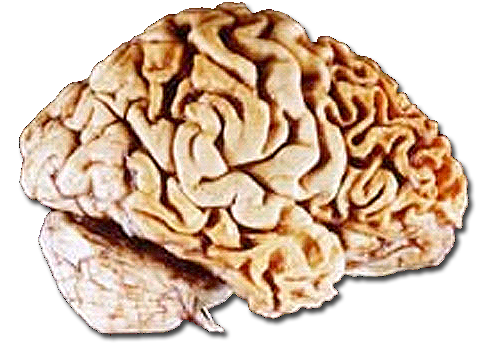Frontotemporal lobar degeneration: Difference between revisions
Kiran Singh (talk | contribs) |
Kiran Singh (talk | contribs) |
||
| Line 38: | Line 38: | ||
===Prevalence=== | ===Prevalence=== | ||
The prevalence of major or mild | The prevalence of major or mild frontotemporal neurocognitive disorder is 2,000-10,000 per 100,000 (2%-10%) of the overall population. | ||
===Age=== | ===Age=== | ||
Revision as of 19:31, 3 November 2014
| Frontotemporal lobar degeneration | |
 | |
|---|---|
| A human brain showing frontotemporal lobar degeneration causing frontotemporal dementia. | |
| OMIM | 600274 |
| DiseasesDB | 10034 |
| MeSH | D003704 |
Editor-In-Chief: C. Michael Gibson, M.S., M.D. [1]; Associate Editor(s)-in-Chief: Kiran Singh, M.D. [2]
Synonyms and keywords: FTLD, frontotemporal lobar degeneration with tau inclusions, ftld with tau inclusions, frontotemporal dementia with parkinsonism, frontotemporal lobe dementia, fldem, ftdp17, multiple system tauopathy with presenile dementia, mstd, disinhibition-dementia-parkinsonism-amyotrophy complex, ddpac, frontotemporal dementia-amyotrophic lateral sclerosis, ftd-als pallidopontonigral degeneration, ppnd
Overview
Frontotemporal lobar degeneration (FTLD) is a pathologic process involving degeneration of gray matter in the frontal lobe and anterior portion of the temporal lobe of the cerebrum, with sparing of the parietal and occipital lobes.
Pathophysiology
The gross finding of frontotemporal lobar degeneration is likely produced by several etiologically distinct processes, with unique genetic and histopathological findings. Accordingly, there are a number of possible histopathological findings at post-mortem:
- tau inclusions (either with Pick bodies or without)
- ubiquitin positive (tau-negative) inclusions - in the majority of cases that have this type of pathology the ubiquitinated inclusions contain a protein called TDP-43. There are three subtypes of this type of pathology. Mackenzie et al (and subsequently Davidson et al) describe the following: type 1 with intranuclear inclusions; type 2 with neurites predominantly and type 3 with cytoplasmic inclusions predominantly. It should be noted that not all ubiquitin-positive, tau negative cases stain for TDP-43 e.g. the CHMP2B cases but also other cases.
- Dementia lacking distinctive histology (DLDH) - A rare and controversial entity - new analyses have allowed many cases to be reclassified into one of the positively-defined subgroups.
Genetics
Many cases (possibly up to 50%) of FTLD are genetic rather than sporadic. Mutations in the Tau gene (on chromosome 17q21 - known as MAPT or Microtubule Associated Protein Tau) can cause FTLD and there are over 40 known mutations at present. A series of new mutations associated with FTLD has been recently described in the progranulin gene which is remarkably also on chromosome 17q21. Patients with progranulin mutations have type 1 TDP-43 positive, tau negative pathology at post-mortem. Progranulin is associated with tumorgenesis when overproduced, whereas the mutations seen in the progranulin gene associated with FTLD suggests a deficit in progranulin may be the problem. There are currently 2 other known genes that can cause FTLD: CHMP2B (on chromosome 3) which is associated with a behavioural syndrome (mainly in a large Jutland cohort); and VCP (valosin-containing protein, on chromosome 9) which is associated with the IBMPFD syndrome (inclusion body myopathy, Paget's disease and frontotemporal dementia). These 2 genes only account for a tiny proportion of cases. A locus on chromosome 9 is associated with FTD-MND (or FTD-ALS) i.e. frontotemporal dementia associated with motor neurone disease (or amyotrophic lateral sclerosis) - the hunt for this gene is currently the focus of a number of research labs around the world.
Differential Diagnosis Of Major or Mild Frontotemporal Neurocognitive Disorder
Epidemiology and Demographics Of Major or Mild Frontotemporal Neurocognitive Disorder
Prevalence
The prevalence of major or mild frontotemporal neurocognitive disorder is 2,000-10,000 per 100,000 (2%-10%) of the overall population.
Age
In the over 65 age group, FTLD is probably the fourth most common cause of dementia after Alzheimer's disease, Dementia with Lewy bodies and vascular dementia. In the below 65 age group, it is the second most common cause after Alzheimer's disease. The process of FTLD is thought to be the main cause of three clinical syndromes: frontotemporal dementia, semantic dementia, and progressive nonfluent aphasia.
Risk Factors Of Major or Mild Frontotemporal Neurocognitive Disorder
Diagnosis
Symptoms
Physical Examination
Neuro
- Ocular motility abnormalities
- Pyramidal tract dysfunction
- Frontal lobe release signs
- Perseverative vocalizations
- Bradykinesia
- Postural instability
Diagnostic Criteria Of Major 0r Mild Frontotemporal Neurocognitive Disorder
DSM-V Diagnostic Criteria for Major Or Mild Frontotemporal Neurocognitive Disorder[1]
| “ |
AND
AND
AND
AND
disorder. Probable frontotemporal neurocognitive disorderis diagnosed if either of the following is present; othenwise, possible frontotemporal neurocognitive disorder should be diagnosed:
2.Evidence of disproportionate frontal and/or temporal lobe involvement from neuroimaging. Possible frontotemporal neurocognitive disorderis diagnosed if there is no evidence of a genetic mutation, and neuroimaging has not been performed. |
” |
References
- ↑ Diagnostic and statistical manual of mental disorders : DSM-5. Washington, D.C: American Psychiatric Association. 2013. ISBN 0890425558.